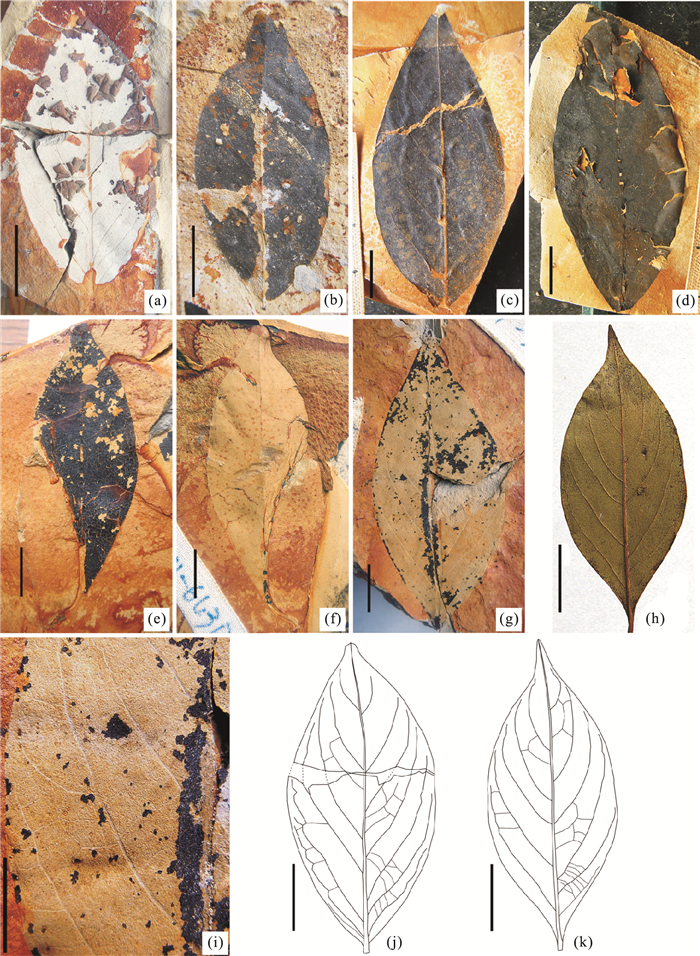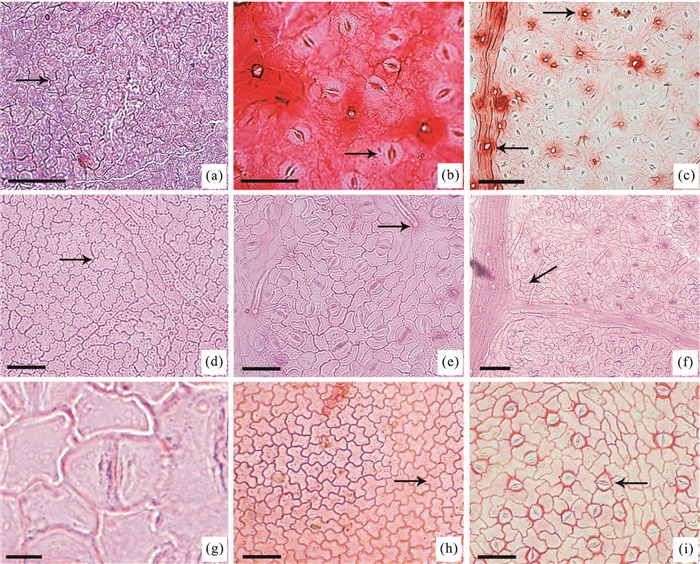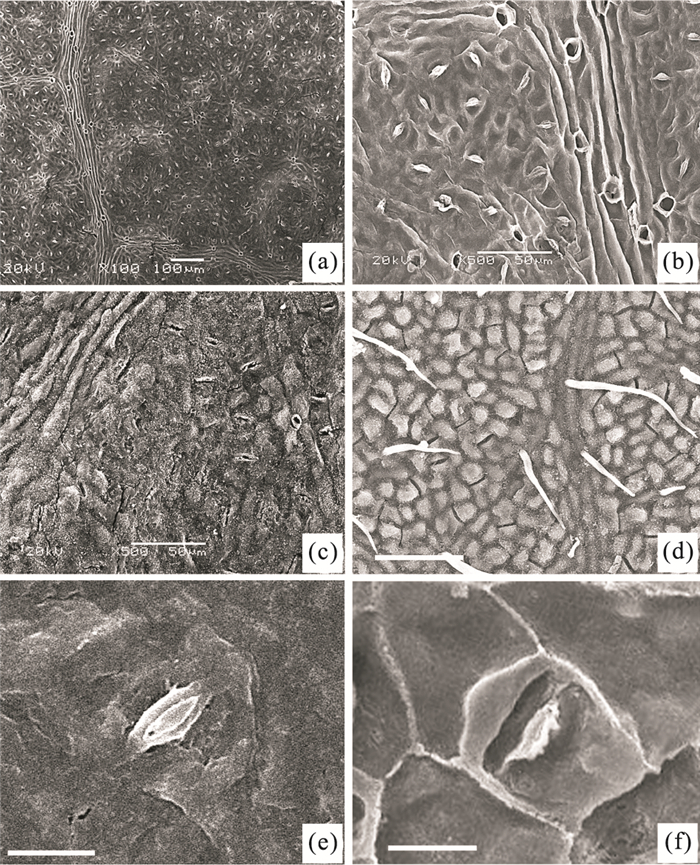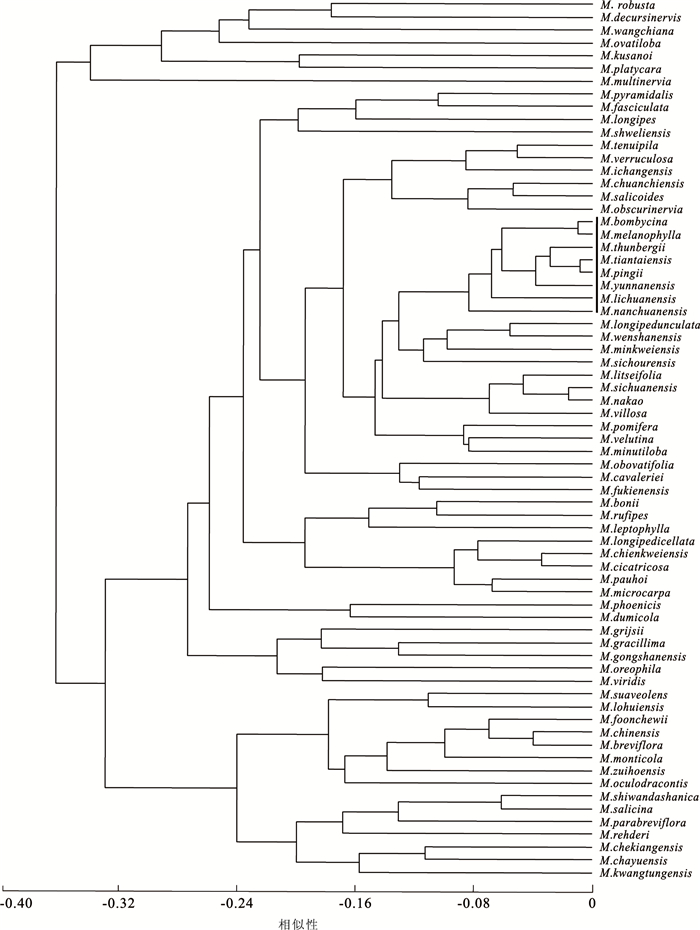Machilus Fossil from Miocene in Tiantai, Zhejiang Province, China, and Its Paleoenvironmental Implications
-
摘要: 对浙江天台中新统下南山组6块叶片压型化石——天台润楠Machilus tiantaiensis Ding S. T. et Sun B. N. sp. nov.,并对其叶结构和表皮构造特征进行了详细的研究.其主要特征为:叶椭圆形,全缘,顶端渐尖,基部楔形,侧脉羽状;表皮细胞垂周壁浅波状,单细胞毛基多集中于脉络区;气孔下生式,气孔器短平列型,副卫细胞1~2个.通过与现生植物进行对比分析,发现当前标本的叶结构和表皮构造特征与樟科润楠属(Machilus)十分一致.利用PAST(palaeontological statistics)软件对我国润楠属68种植物叶片的形态特征进行聚类分析,结果表明当前化石与M. pingii Cheng ex Yang最为接近;角质层分析也表明二者的表皮构造最为相似.利用化石与其现存最近亲缘种M. pingii的气孔比率,恢复了天台晚中新世的古大气CO2体积分数为407.9×10-6.此外,依据现生润楠属主要分布于亚洲东南部和南部的热带、亚热带地区,推断天台地区中新世的古气候较为温暖湿润.Abstract: Six fossil leaves with fine venation and well-preserved cuticles of Machilus tiantaiensis Ding S. T. et Sun B. N. sp. nov. (Lauraceae) were discovered from the Late Miocene Xiananshan Formation of Tiantai County, eastern Zhejiang Province, China. The fossils were characterized by elliptic shape with entire margin, acuminate apex, cuneate base and pinnate venation; the anticlinal walls of epidermal cells are undulated, the unicellular trichome bases are mostly found on the veins; leaves hypostomatic, stomata paracytic with two embedded guard cells and one or two subsidiary cells. The leaf cuticular and architectural features of these fossil leaves suggest the affinity within the genus Machilus. The quantitative traits of leaf morphology were studied here, and a free data analysis package (palaeontological statistics) is utilized for cluster analysis. The leaf morphologic and cuticular features show that the fossil is similar to the modern leaves of M. pingii mostly. The paleoatmospheric CO2 concentration is estimated through the stomatal ratio between the fossil species and the extant M. pingii Cheng ex Yang (nearest living relative of the fossil species), and the result shows that the level of atmospheric CO2 in the Late Miocene of Tiantai is about 407.9×10-6. The modern trees of Machilus are distributed in tropical and subtropical regions of South and Southeast Asia, which indicates that the Miocene climate of eastern China was warm and humid.
-
Key words:
- Machilus /
- cuticle /
- cluster analysis /
- plant fossils /
- paleoenvironment /
- Miocene /
- climate change
-
图 2 Machilus tiantaiensis和M. pingii的叶结构特征
a~g.M. tiantaiensis手标本;a.标本号:JH14147;b.标本号:JH14276;c.标本号:JH14271;d.标本号:JH14282;e.标本号:JH14643A;f.标本号:JH14643B;g.标本号:JH14585;h.M. pingii;标本号:LUP080918;i.M. tiantaiensis,示脉络结构,标本号:JH14585;j.化石叶片素描图,标本号:JH14147;k.现生叶片素描图,标本号:LUP080918.a~h, j, k的标尺=1.0 cm;i的标尺=0.5 cm
Fig. 2. Leaf architectures of Machilus tiantaiensis and M. pingii
图 3 在光学显微镜(LM)下M. tiantaiensis、M. pingii和M. yunnanensis角质层特征
a.M. tiantaiensis上表皮,箭头示垂周壁,标本号:JH14643;b.M. tiantaiensis下表皮,箭头示气孔器,标本号:JH14147;c.M. tiantaiensis下表皮,箭头分别示脉络和毛状体,标本号:JH14585;d.M. pingii上表皮,箭头示垂周壁,标本号:LUP080918;e.M. pingii下表皮,箭头分别示气孔器和毛状体,标本号:LUP080918;f.M. pingii下表皮,箭头示脉络,标本号:LUP080918;g.M. pingii下表皮,箭头示气孔器,标本号:LUP080918;h.M. yunnanensis上表皮,箭头示垂周壁,标本号:LUP061012;i.M. yunnanensis下表皮,箭头示气孔器,标本号:LUP061012.a, b, d, e, h, i的标尺=50 μm;c, f的标尺=100 μm;g的标尺=10 μm
Fig. 3. Cuticular characteristics of Machilus tiantaiensis, M. pingii and M. yunnanensis under the light microscopy
图 4 在扫描电镜(SEM)下M. tiantaiensis和M. pingii角质层特征
a.M. tiantaiensis下表皮内面观,标本号:JH14147;b.M. tiantaiensis下表皮内面观,标本号:JH14147;c.M. tiantaiensis下表皮外面观,标本号:JH14282;d.M. pingii下表皮外面观,标本号:LUP080918;e.M. tiantaiensis下表皮,示气孔器,标本号:JH14147;f.M. pingii下表皮,示气孔器,标本号:LUP080918.a的标尺=100 μm;b~d的标尺= 50 μm;e, f的标尺=10 μm
Fig. 4. Cuticular characteristics of M. tiantaiensis and M. pingii under the scanning electron microscope
表 1 分类性状及编码
Table 1. Taxonomic characters and codes
序号 分类性状及编码 1 叶片长度(cm) 2 叶片宽度(cm) 3 叶片长/叶片宽 4 叶基形状:楔形(0);宽楔形或圆形(1);钝(2);下延或急短尖(3) 5 叶顶:渐尖(0);尾状渐尖(1);短尖(2);钝或圆(3) 6 叶片质地:坚纸质(0);薄革质(1);革质(2);厚革质(3) 7 叶侧脉数(对):<7(0);7~9(1);9~12(2);>12(3) 8 侧脉与中脉的夹角:<30°(0);30°~45°(1);45°~60°(2);>60°(3) 表 2 润楠属叶化石记录
Table 2. Leaf fossil records of genus Machilus
种名 叶形 大小(cm) 叶顶 叶基 叶缘 侧脉(对) 时代 地点 参考文献 M. thunbergii 披针形、椭圆形 (10.3~11.5)×(1.9~5.0) 短尖 楔形 全缘 9~10 早更新世 广西百色 刘裕生,1993 M. oreophila 披针形 15.2×3.8 短尖 楔形 全缘 15 早更新世 广西百色 刘裕生,1993 M. leplophylla 倒卵状长圆形 15.0×5.0 - 楔形 全缘 >10 上新世 云南腾冲 吴靖宇等,2008 M. cf. longipedicellata 长椭圆形 18.0×5.0 渐尖 楔形 全缘 10 上新世 云南腾冲 吴靖宇等,2008 M. americana 椭圆状披针形 4.7×1.9 - 楔形 全缘 - 晚中新世 云南开远 周浙昆,2000 M. ugoana 椭圆状倒披针形 5.9×1.8 - 楔形 全缘 >8 晚中新世 云南开远 周浙昆,2000 M. ugoana - 8.0×2.5 - 楔形 全缘 - 中中新世 日本岐阜 Ina, 2004 M. nathorsti 卵圆形 8.0×3.0 渐尖 狭楔 全缘 6 中中新世 日本岐阜 Ina, 2004 M. ugoana 椭圆形,长椭圆形,椭圆状披针形 (4.8~11.2)×(1.7~4.0) 渐尖 楔形 全缘 10~12 中新世 日本兵库 Uemura, 2005 M. ugoana 披针形 9.7×2.3 短尖 狭楔 全缘 9 早中新世 日本本州 Yabe, 2008 M. nathorsti - - 渐尖 全缘 - 早中新世 日本本州 Yabe, 2008 M. ugoana 椭圆状披针形 7.0×1.7 - - 全缘 7 渐新世 云南景谷 中国新生代植物编写组,1978 M. tiantaiensis 椭圆形,卵状椭圆形 (4.1~6.5)×(2.0~2.8) 渐尖 楔形 全缘 7~9 晚中新世 浙江天台 本文 表 3 植物化石M. tiantaiensis与3种叶结构关系较近的现生润楠属植物叶片角质层特征
Table 3. Characteristics and correlations of the cuticle from M. tiantaiensis and extant three species of Machilus
种类 上表皮 下表皮 参考文献 细胞形状 垂周壁 细胞形状 垂周壁 气孔密度(个/mm2) 气孔器长(μm) (μm) 气孔器长宽比 气孔器分布 表皮毛 M. pingii 不规则 浅波状 不规则 弧形或浅波状 430 22.5 20.6 1.09 星状 有 本文 M. yunnanensis 不规则 深波状 不规则 浅波状 420 17.4 16.2 1.07 星状 无 本文 M. thunbergii 4~5边形 平直 不规则 平直 248 15.5 15.5 1.00 群状 无 * M. tiantaiensis 不规则 浅波状 不规则 浅波状 488 21.7 20.5 1.06 星状 有 本文 注:星号表示据林夏珍,2007b;气孔密度、气孔器长和气孔器宽均指平均值. 表 4 M. tiantaiensis和M. pingii下表皮气孔参数
Table 4. Stomatal parameters of the lower surface of M. tiantaiensis and M. pingii
种类 数据组序号 气孔密度(SD,个/mm2) 表皮细胞密度(ED,个/mm2) 气孔指数(SI,%) M. tiantaiensis 1 436 2 956.0 12.9 2 496 3 527.0 12.3 3 452 3 115.0 12.7 4 512 3 484.0 12.8 5 507 3 646.5 12.2 6 487 3 643.5 11.8 7 529 3 811.5 12.2 平均值 488(±31) 12.4(±0.4) M. pingii 1 420 2 830.0 12.9 2 439 2 864.5 13.3 3 435 2 844.5 13.3 4 396 2 675.0 12.9 5 439 2 767.5 13.7 6 528 3 722.0 12.4 7 493 3 280.5 13.1 平均值 450(±42) 13.1(±0.4) -
Bandulska, H., 1926. On the cuticles of some fossil and recent lauraceae. Botanical Journal of the Linnean Society, 47: 383-425. doi: 10.1111/j.1095-8339.1926.tb00517.x Barclay, R., McElwain, J., Dilcher, D., et al., 2007. The cuticle database: developing an interactive tool for taxonomic and paleoenvironmental study of the fossil cuticle record. Courier Forschungsinstitut Senckenberg, 258: 39-55. http://www.springerlink.com/content/w4765w6817k0t852 Beerling, D.J., Berner, R.A., 2005. Feedbacks and the coevolution of plants and atmospheric CO2. Proceedings of the National Academy of Sciences, 102(5): 1302-1305. doi: 10.1073/pnas.0408724102 Beerling, D.J., Lomax, B.H., Royer, D.L., et al., 2002. An atmospheric pCO2 reconstruction across the Cretaceous-Tertiary boundary from leaf megafossils. Proceedings of the National Academy of Sciences, 99(12): 7836-7840. doi: 10.1073/pnas.122573099 Carpenter, R.J., Jordan, G.J., Hill, R.S., 2007. A toothed lauraceae leaf from the Early Eocene of Tasmania, Australia. International Journal of Plant Sciences, 168(8): 1191-1198. doi: 10.1086/520721 Christophel, D.C., Kerrigan, R., Rowett, A.I., 1996. The use of cuticular features in the taxonomy of the lauraceae. Annals of the Missouri Botanical Garden, 83(3): 419-432. doi: 10.2307/2399871 Christophel, D.C., Rowett, A.I., 1996. Leaf and cuticle atlas of Australian leafy lauraceae. Australian Biological Resources Study, Flora of Australia supplementary series 6, Canberra. http://www.cabdirect.org/abstracts/19970607928.html Dilcher, D.L., 1974. Approaches to the identification of angiosperm leaf remains. The Botanical Review, 40(1): 1-157. doi: 10.1007/BF02860067 Ding, C.S., 1992. Lauraceae. In: Wang, J.X., ed., Flora of Zhejiang, Vol. 2. Zhejiang Science and Technology Publishing House, Hangzhou, 355-361 (in Chinese). Drinnan, A.N., Crane, P.R., Friis, E.M., et al., 1990. Lauraceous flowers from the Potomac Group (Mid-Cretaceous) of eastern North America. Botanical Gazette, 151(3): 370-384. doi: 0006-8071/90/5103-0009 Edwards, H.H., 1990. The stomatal complex of Persea borbonia. Canadian Journal of Botany, 68(12): 2543-2547. doi: 10.1139/b90-320 Eklund, H., Kva ek, J., 1998. Lauraceous inflorescences and flowers from the Cenomanian of Bohemia (Czech Republic, central Europe). International Journal of Plant Sciences, 159(4): 668-686. doi: 1058-5893/98/5904-0016 Faggetter, C.D., 1987. Leaf cuticles (phytoglyphs) of selected Lauraceae. In: Metcalfe, C.R., ed., Anatomy of the dicotyledons, 2nd ed., Vol. Ⅲ. Magnoliales, Illiciales, and Laurales. Claredon Press, Oxford, 157-160. Frumin, S., Eklund, H., Friis, E.M., 2004. Mauldinia hirsuta sp. nov., a new member of the extinct genus Mauldinia (Lauraceae) from the Late Cretaceous (Cenomanian-Turonian) of Kazakhstan. International Journal of Plant Sciences, 165(5): 883-895. doi: 1058-5893/2004/16505-0019 Hammer, O., Harper, D.A.T., Ryan, P.D., 2009. PAST-palaeontological statistics. Version 1.88, 1-89. Hetherington, A.M., Woodward, F.I., 2003. The role of stomata in sensing and driving environmental change. Nature, 424: 901-908. doi: 10.1038/nature01843 Hill, R.S., 1986. Lauraceous leaves from the Eocene of Nerriga, New South Wales. Alcheringa, 10: 327-351. doi: 10.1080/03115518608619144 Ho, K.S., Chen, J.C., Lo, C.H., et al., 2003. 40Ar-39Ar dating and geochemical characteristics of Late Cenozoic basaltic rocks from the Zhejiang-Fujian region, SE China: eruption ages, magma evolution and petrogenesis. Chemical Geology, 197: 287-318. doi: 10.1016/S0009-2541(02)00399-6 Hu, Y.Q., Ferguson, D.K., Li, C.S., et al., 2007. Alseodaphne (Lauraceae) from the Pliocene of China and its paleolimatic significance. Review of Palaeobotany and Palynology, 146: 277-285. doi: 10.1016/j.revpalbo.2007.06.002 Huzioka, K., Takahasi, E., 1970. The Eocene flora of the Ube coal-field, Southwest Honshu, Japan. Journal of the Mining College, Akita University (Ser. A), 4: 1-88. http://www.researchgate.net/publication/284340117_The_Eocene_flora_of_the_Ube_coal-field_southwest_Honshu_Japan Ina, H., 2004. Plants from the Middle Miocene Shukunohora sandstone facies of the Mizunami group, Mizunami city, Gifu prefecture, Central Japan. Bulletin of the Mizunami Fossil Museum, 31: 73-76 (in Japanese with an English abstract). Jia, H., Sun, B.N., Li, X.C., et al., 2009. Microstructures of one species of Quercus from the Neogene in eastern Zhejiang and its palaeoenvironmental indication. Earth Science Frontiers, 16(5): 79-90 (in Chinese with an English abstract). http://en.cnki.com.cn/Article_en/CJFDTotal-DXQY200905011.htm Kerp, H., 1990. The study of fossil gymnosperms by means of cuticular analysis. Palaios, 5(6): 548-569. doi: 10.2307/3514861 Kerp, H., 2002. Atmospheric CO2 from fossil plant cuticles. Nature, 415: 38. doi: 10.1038/415038b Kürschner, W.M., Van der Burgh, J., Visscher, H., et al., 1996. Oak leaves as biosensors of Late Neogene and Early Pleistocene paleoatmospheric CO2 concentrations. Marine Micropaleontology, 27: 299-312. doi: 10.1016/0377-8398(95)00067-4 Kürschner, W.M., 1997. The anatomical diversity of recent and fossil leaves of the durmast oak (Quercus petraea Lieblein/Q. pseudocastanea Goeppert): implications for their use as biosensors of palaeoatmospheric CO2 levels. Review of Palaeobotany and Palynology, 96: 1-30. doi: 10.1016/S0034-6667(96)00051-6 Kürschner, W.M., Kva ek, Z., Dilcher, D.L., 2008. The impact of Miocene atmospheric carbon dioxide fluctuations on climate and the evolution of terrestrial ecosystems. Proceedings of the National Academy of Sciences, 105(2): 449-453. doi: 10.1073/pnas.0708588105 Kürschner, W.M., Wagner, F., Visscher, E.H., et al., 1997. Predicting the response of leaf stomatal frequency to a future CO2-enriched atmosphere: constraints from historical observations. Geologische Rundschau, 86(2): 512-517. doi: 10.1007/s005310050158 Lakhanpal, R.N., 1958. The Rujada Flora of West Central oregon. University of California Publications in Geological Sciences, 35(1): 1-66. http://www.researchgate.net/publication/284993617_The_Rujada_flora_of_west_central_Oregon LAWG (leaf architecture working group), 1999. Manual of leaf architecture: morphological description and categorization of dicotyledonous and net-veined monocotyledonous angiosperms. Smithsonian Institution, Washington D.C., 1-65. http://www.researchgate.net/publication/270216765_Manual_of_Leaf_Architecture_-_Morphological_description_and_categorization_of_dicotyledonous_and_net-veined_monocotyledonous_angiosperms Li, S.G., 1982. Machilus Nees. In: Li, X.W., ed., Flora reipublicae popularis sinicae. Science Press, Beijing (in Chinese). Li, H.M., 1984. Neogene floras from eastern Zhejiang, China. In: Whyte, R.O., ed., The evolution of the East Asian environment, Vol. Ⅱ. Palaeobotany, palaeozoology and palaeoanthropology, centre of Asian studies. University of Hong Kong, Hong Kong, 461-466. Li, J.Z., Qiu, J., Liao, W.B., et al., 2009. Eocene fossil Alseodaphne from Hainan Island of China and its paleoclimatic implications. Science in China (Ser. D), 52(10): 1537-1542. doi: 10.1007/s11430-009-0120-1 Li, J., Christophel, D.C., 2000. Systematic relationships within the Litsea complex (lauraceae): a cladistic analysis based on morphological and leaf cuticle data. Australian Systematic Botany, 13: 1-13. doi: 10.1071/SB98015 Li, J., Li, X.W., 2004. Advances in lauraceae systematic research on the world scale. Acta Botanica Yunnanica, 26 (1): 1-11 (in Chinese with an English abstract). http://europepmc.org/abstract/CBA/358677 Lin, X.Z., 2007a. Quantitative classification of plants of machilus in Zhejiang Province. Scientia Silvae Sinicae, 43(11): 151-156 (in Chinese with an English abstract). http://en.cnki.com.cn/Article_en/CJFDTOTAL-LYKE200711026.htm Lin, X.Z., 2007b. The systematical studies on species from genus Machilus in Zhejiang Province. China Forestry Publishing House, Beijing (in Chinese). Little, S.A., Stockey, R.A., Penner, B., 2009. Anatomy and development of fruits of lauraceae from the Middle Eocene Princeton. American Journal of Botany, 96(3): 637-651. doi: 10.3732/ajb.0800318 Liu, R.X., Chen, W.J., Sun, J.Z., et al., 1992. The K-Ar age and tectonic environment of Cenozoic rock in China. In: Liu, R.X., ed., The age and geochemistry of Cenozoic volcanic rock in China. Seismic Press, Beijing, 1- 43 (in Chinese). Liu, Y.S., 1990. Cuticular studies on two Pleistocene species of lauraceae in Baise basin, Guangxi. Acta Botanica Sinica, 32(10): 805-808 (in Chinese with an English abstract). http://www.cabdirect.org/abstracts/19910649862.html Liu, Y.S., 1993. A palaeoclimatic analysis on Early Pleistocene flora of Changsheling Formation, Baise basin, Guangxi. Acta Palaeontologica Sinica, 32: 151173 (in Chinese with an English abstract). http://en.cnki.com.cn/Article_en/CJFDTOTAL-GSWX199302003.htm Liu, Y.S., Zetter, R., Ferguson, D.K., et al., 2007. Discriminating fossil evergreen and deciduous Quercus pollen: a case study from the Miocene of eastern China. Review of Palaeobotany and Palynology, 145: 289-303. doi: 10.1016/j.revpalbo.2006.12.001 Liu, Y.S., Zetter, R., Ferguson, D.K., et al., 2008. Lagerstroemia (lythraceae) pollen from the Miocene of eastern China. Grana, 47(4): 262-271. doi: 10.1080/00173130802457255 McElwain, J.C., 1998. Do fossil plants signal palaeoatmospheric carbon dioxide concentration in the geological past?Philosophical Transactions of the Royal Society of London-series B, 353(1365): 83-96. doi: 10.1098/rstb.1998.0193 McElwain, J.C., Chaloner, W.G., 1996. The fossil cuticle as a skeletal record of environmental change. Palaios, 11(4): 376-388. doi: 10.2307/3515247 Nanjing Institute of Geology and Mineral Resources, 1982. Paleontological Atlas of East China, Vol. 3., Mesozoic and Cenozoic. Geological Publishing House, Beijing (in Chinese). Osborne, C.P., Beerling, D.J., Lomax, B.H., et al., 2004. Biophysical constraints on the origin of leaves inferred from the fossil record. Proceedings of the National Academy of Sciences, 101(28): 10360-10362. doi: 10.1073/pnas.0402787101 Pole, M., 2007. Lauraceae macrofossil and dispersed cuticle from the Miocene of southern New Zealand. Palaeontologia Electronica, 10(1): 1-10. http://www.researchgate.net/publication/43474496_Lauraceae_Macrofossils_and_Dispersed_Cuticle_from_the_Miocene_of_Southern_New_Zealand Royer, D.L., Wing, S.L., Beerling, D.J., et al., 2001. Paleobotanical evidence for near present-day levels of atmospheric CO2 during part of the Tertiary. Science, 292(5525): 2310-2313. doi: 10.1126/science.292.5525.2310 Salisbury, E.J., 1927. On the causes and ecological significance of stomatal frequency, with special reference to the Woodland flora. Philosophical Transactions of the Royal Society of London-series B, 216: 1-65. http://www.onacademic.com/detail/journal_1000036014533910_1603.html Sun, Q.G., Song, S.Y., Wang, Y.F., et al., 1997. Introduction to terminology of classification of dicotyledonous leaf architecture. Acta Phytotaxonomica Sinica, 35(3): 275-288 (in Chinese with an English abstract). http://europepmc.org/abstract/CBA/304684 Uemura, K., 2005. Ⅳ. Fossil of Plant. In: Kasumi Education Committee, ed., The investigation report of footprint fossils from Kasumi. Kasumi, 67-77 (in Japanese). Upchurch, G.R., Dilcher, D.L., 1990. Cenomanian angiosperm leaf megafossils, Dakota Formation, Rose Creek locality, Jefferson County, southeastern Nebraska. U.S. Geological Survey Bulletin, 1915: 1-55. http://www.researchgate.net/publication/36442572_Cenomanian_Angiosperm_Leaf_Megafossils_Dakota_Formation_Rose_Creek_Locality_Jefferson_County_Southeastern_Nebraska Upchurch, G.R., 1995. Dispersed angiosperm cuticles: their history, preparation, and application to the rise of angiosperms in Cretaceous and Paleocene coals, southern western interior of North America. International journal of coal geology, 28: 161-227. doi: 10.1016/0166-5162(95)00018-6. Van der Burgh, J., Visscher, H., Dilcher, D.L., et al., 1993. Paleoatmospheric signatures in Neogene fossil leaves. Science, 260(5115): 1788-1790. doi: 10.1126/science.260.5115.1788 Wilkinson, H.P., 1979. The plant surface (mainly leaf). In: Metcalf, C.R., Chalk, L., eds., Anatomy of the dicotyledons. I. Clarendon Press, Oxford 2nd ed., 97-165. Wolfe, J.A., 1977. Paleogene floras from the Gulf of Alaska region. Geological Survey Professional Paper, 997: 1-108. http://www.researchgate.net/publication/285426059_Paleogene_floras_from_the_Gulf_of_Alaska_Region Woodward, F.I., 1987. Stomatal numbers are sensitive to increases in CO2 from pre-industrial levels. Nature, 327: 617-618. doi: 10.1038/327617a0 Writing Group of Cenozoic Plants of China, 1978. Fossil Plants of China, Vol. 3: Cenozoic plants from China. Science Press, Beijing, 24 (in Chinese). Wu, J.Y., Sun, B.N., Xie, S.P., et al., 2008. Two Neogene machilus (lauraceae) fossils leaves from Tengchong, Yunnan Province and its paleoenvironmental significance. Geological Journal of China Universities, 14(1): 90-98 (in Chinese with an English abstract). http://www.researchgate.net/publication/285786310_Two_Neogene_Machilus_Lauraceae_fossil_leaves_from_Tengchong_Yunnan_Province_and_its_paleoenvironmental_significance Xia, K., Su, T., Liu, Y.S., et al., 2009. Quantitative climate reconstructions of the Late Miocene Xiaolongtan megaflora from Yunnan, Southwest China. Palaeogeography, Palaeoclimatology, Palaeoecology, 276: 80-86. doi: 10.1016/j.palaeo.2009.02.024 Xu, Y.D., Yu, J.X., Luo, G.M., et al., 2007. Triassic palynological assemblage of the Gulangdi Formation in Tongren County, Qinghai Province, China. Earth Science—Journal of China University of Geosciences, 32(5): 638-650 (in Chinese with an English abstract). http://www.researchgate.net/publication/286919446_Triassic_palynological_assemblage_of_the_Gulangdi_formation_in_Tongren_County_Qinghai_Province_China Yabe, A., 2008. Early Miocene terrestrial climate inferred from plant megafossil assemblages of the Joban and Soma areas, Northeast Honshu, Japan. Bulletin of the Geological Survey of Japan, 59(7/8): 397-413. http://www.researchgate.net/publication/271106331_Early_Miocene_terrestrial_climate_inferred_from_plant_megafossil_assemblages_of_the_Joban_and_Soma_areas_Northeast_Honshu_Japan Yin, J.R., Cui, Z.J., Ge, D.K., et al., 1996. Paleoecological analysis of quateranry fossil assemblages from Kunlun pass area, and geological significance for Kunlun Mountains rising. Earth Science—Journal of China University of Geosciences, 21(3): 241-248 (in Chinese with an English abstract). http://en.cnki.com.cn/Article_en/CJFDTOTAL-DQKX603.001.htm Zhou, Z.K., 2000. On the Miocene Xiaolongtan flora from Kaiyuan, Yunnan Province. In: Tao, J.R., ed., The evolution of the Late Cretaceous-Cenozoic floras in China. Science Press, Beijing, 64-72 (in Chinese). Zhuang, X.Y., Zhang, Y., Sun, T.X., 2002. Leaf epidermis and their taxonomic significance in Machilus of Hong Kong. Journal of South China Agricultural University, 23(1): 52-54 (in Chinese with an English abstract). http://europepmc.org/abstract/CBA/367907 地质矿产部南京地质矿产研究所, 1982. 华东地区古生物图册(三), 中、新生代分册. 北京: 地质出版社. 丁陈森, 1992. 樟科. 见: 王景祥, 主编. 浙江植物志, 第2卷. 杭州: 浙江科学技术出版社, 355-361. 贾慧, 孙柏年, 李相传, 等, 2009. 浙东新近纪一种栎属植物化石微细特征及其古环境指示. 地学前缘, 16(5): 79-90. doi: 10.3321/j.issn:1005-2321.2009.05.008 李捷, 李锡文, 2004. 世界樟科植物系统学研究进展. 云南植物研究, 26(1): 1-11. doi: 10.3969/j.issn.2095-0845.2004.01.001 李树刚, 1982. 润楠属. 见: 李锡文主编, 中国植物志. 北京: 科学出版社. 林夏珍, 2007a. 浙江润楠属植物的数量分类. 林业科学, 43(11): 151-156. https://www.cnki.com.cn/Article/CJFDTOTAL-LYKE200711026.htm 林夏珍, 2007b. 浙江省润楠属植物系统研究. 北京: 中国林业出版社. 刘若新, 陈文寄, 孙建中, 等, 1992. 中国新生代火山岩的K-Ar年代与构造环境. 见: 刘若新编. 中国新生代火山岩年代学与地球化学. 北京: 地震出版社, 1-43. 刘裕生, 1990. 广西百色盆地更新世樟科两种植物角质层研究. 植物学报, 32(10): 805-808. https://www.cnki.com.cn/Article/CJFDTOTAL-ZWXB199010012.htm 刘裕生, 1993. 广西百色盆地早更新世长蛇岭组植物群的古气候分析. 古生物学报, 32(2): 151-173. https://www.cnki.com.cn/Article/CJFDTOTAL-GSWX199302003.htm 孙启高, 宋书银, 王宇飞, 等, 1997. 介绍双子叶植物叶结构分类术语. 植物分类学报, 35(3): 275-288. https://www.cnki.com.cn/Article/CJFDTOTAL-ZWFX199703014.htm 吴靖宇, 孙柏年, 解三平, 等, 2008. 云南腾冲新近系樟科润楠属两种植物化石及其古环境意义. 高校地质学报, 14(1): 90-98. doi: 10.3969/j.issn.1006-7493.2008.01.010 徐亚东, 喻建新, 罗根明, 等, 2007. 青海省同仁县古浪堤中上三叠统古浪堤组孢粉组合及其地层意义. 地球科学——中国地质大学学报, 32(5): 638-650. https://www.cnki.com.cn/Article/CJFDTOTAL-DQKX200705009.htm 阴家润, 崔之久, 葛道凯, 等, 1996. 昆仑山口第四纪化石组合的生态环境分析及其对昆仑山隆升的意义. 地球科学——中国地质大学学报, 21(3): 243-248. https://www.cnki.com.cn/Article/CJFDTOTAL-DQKX603.001.htm 中国科学院北京植物研究所中国新生代植物编写组, 1978. 中国各门类化石中国植物化石第三册, 中国新生代植物. 北京: 科学出版社, 24. 周浙昆, 2000. 云南开远小龙潭中新世植物. 见: 陶君容编. 中国晚白垩世至新生代植物区系发展演变. 北京: 科学出版社, 64-72. 庄雪影, 张粤, 孙同兴, 2002. 香港润楠属植物叶表皮形态及分类学意义. 华南农业大学学报, 23(1): 52-54. https://www.cnki.com.cn/Article/CJFDTOTAL-HNNB200201014.htm -









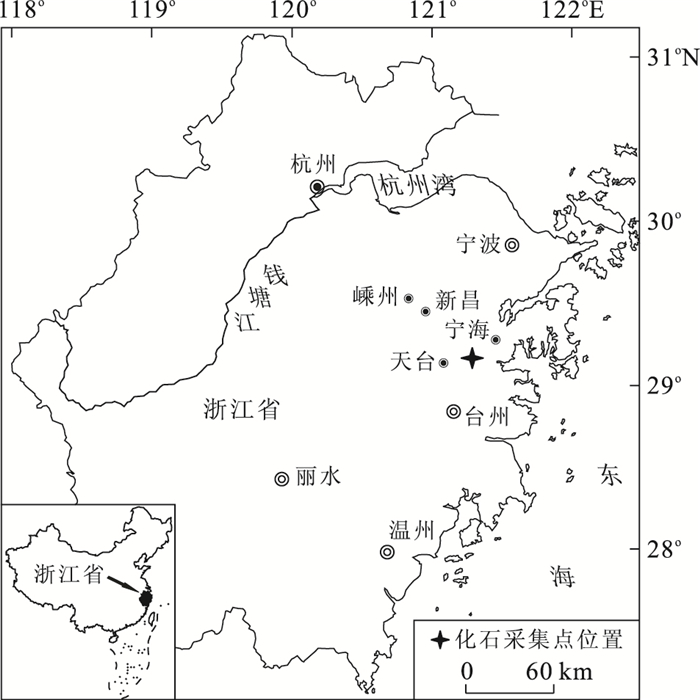
 下载:
下载:
